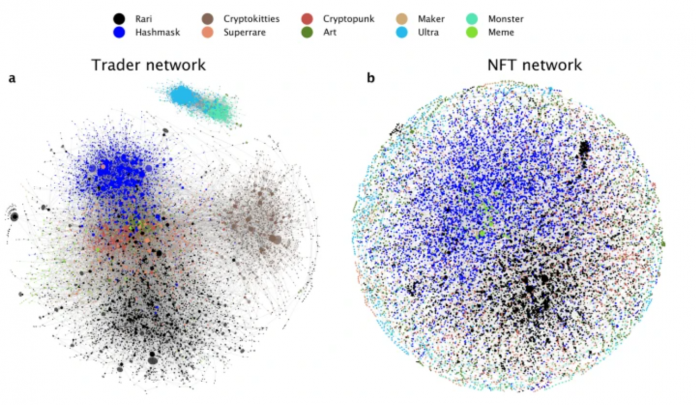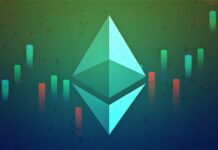Coverage of NFTs in 2021 has been chock-full of utopian buzzwords that hail their “revolutionary” and “democratic” potential for upending the art market. A new study published in Nature Scientific Reports confirms detractors’ suspicions that the NFT market is likely reproducing similar dynamics at play in the art world today. Ten percent of NFT buyers and sellers make as many transactions as the remaining 90 percent, it found, suggesting high concentration in the NFT marketplace. This statistic suggests that decentralized marketplaces have given way to more specialized platforms, which have come to occupy similar roles as gallerists and brand names in the non-crypto economy. The study also revealed that the average sale price of three-quarters of NFTs is just $15; meanwhile, only 1% of NFTs sell for over $1,594.
The paper was lead-authored by Andrea Baronchelli, a professor of mathematics at City, University of London and founder of the Token Economy group at the Alan Turing Institute. It is, as far as he knows, the first study to systematically provide a quantitative survey of the NFT market. “We are really the first to map the structure of the network, and the influence of different collections at different times,” Baronchelli tells Hyperallergic.
By supplying basic metrics on the trade of NFTs in the past four years, the study cautions against blind optimism of the revolutionary potential of NFTs.
NFTs, or non-fungible tokens, are digital tokens on a cryptocurrency’s blockchain that can be used to represent the unique fingerprint of otherwise reproducible items like photos, graphics, music, or other virtual objects. According to the study, popular trade in NFTs first took place in 2017 — before they were even referred to as NFTs — in the blockchain game CryptoKitties, which allows players to collect, breed, buy, and sell virtual cats. At that point in time, Baronchelli notes, NFTs appeared in media coverage “only as an example of the madness of the cryptocurrency world.”
In mid-2020, NFTs began to expand beyond the CryptoKitties niche, as art and collectible platforms along with major brands started selling NFT products. By the end of the year, the NFT market had grown by almost 300%. Beeple’s $69.3 million sale of his digital collage EVERYDAYS: THE FIRST 5000 DAYS at Christie’s — the first NFT to be sold by a major auction house — made NFTs a household name in March 2021. It was the third highest sale price achieved by a living artist at auction.
Beeple’s sale initiated a flurry of conversations around the transformative possibilities NFTs could have on shaking up the stodgy and hierarchical art market. Crypto enthusiasts and skeptics alike wondered if NFTs would eliminate intermediaries like art dealers and galleries, hence “democratizing” access to the art market. Artists without representation could more easily offer their work for sale, and buyers and investors would not have to rely on middlemen to make transactions. “The art oligarchy no longer holds the keys to the empire,” one writer rejoiced.
The complexity of dealing with cryptocurrency for the average person, along with the impulse to trust tastemakers, has made the market less horizontal than some would like to believe. The concentration of transactions among a small group of traders suggests that key players are emerging in the NFT marketplace, much as they exist in the art world.
“If you read the press in January of this year, the idea was that we are opening up the system of art — bypassing the intermediaries and producing to mainstream market directly,” Baronchelli says. “Marketplaces have now been created whose role is to curate the selection of a number of artists, which will then sell for a higher price… It’s recreating some of the structures of the traditional art market.” SuperRare and Foundation are two prominent examples of such marketplaces. Baronchelli doesn’t discount the promise NFT markets offer for newcomers to enter, but emphasizes that “we are observing an increasingly gate-kept community.”
“There are big players that make up most of the market… If you manage to enter in the right portion of the network of buyers and sellers, where the big players are, your chances of success are surely higher,” he says.
Another research question the authors sought to answer was what factors determine the sale price of NFTs. Across all categories of NFTs, they found that the market history of similar NFTs was the best predictor of an NFT’s price. Among NFTs categorized as art, their machine-learning algorithm showed that highly-priced NFTs share similar visual characteristics — though they are not yet able to identify which specific patterns or traits are valued most highly.
Credit: Source link






















 Bitcoin
Bitcoin  Ethereum
Ethereum  Tether
Tether  Solana
Solana  USDC
USDC  Lido Staked Ether
Lido Staked Ether  XRP
XRP  Toncoin
Toncoin  Dogecoin
Dogecoin  Cardano
Cardano  Shiba Inu
Shiba Inu  Avalanche
Avalanche  Wrapped Bitcoin
Wrapped Bitcoin  TRON
TRON  Bitcoin Cash
Bitcoin Cash  Polkadot
Polkadot  Chainlink
Chainlink  Polygon
Polygon  NEAR Protocol
NEAR Protocol  Litecoin
Litecoin  Internet Computer
Internet Computer  Uniswap
Uniswap  LEO Token
LEO Token  Dai
Dai  Aptos
Aptos  Mantle
Mantle  Ethereum Classic
Ethereum Classic  First Digital USD
First Digital USD  Stacks
Stacks  OKB
OKB  Cronos
Cronos  Filecoin
Filecoin  Cosmos Hub
Cosmos Hub  Stellar
Stellar  Bittensor
Bittensor  Render
Render  Arbitrum
Arbitrum  Hedera
Hedera  Immutable
Immutable  Maker
Maker  dogwifhat
dogwifhat  Injective
Injective  The Graph
The Graph  Ethena USDe
Ethena USDe  Optimism
Optimism  Wrapped eETH
Wrapped eETH  Pepe
Pepe 
